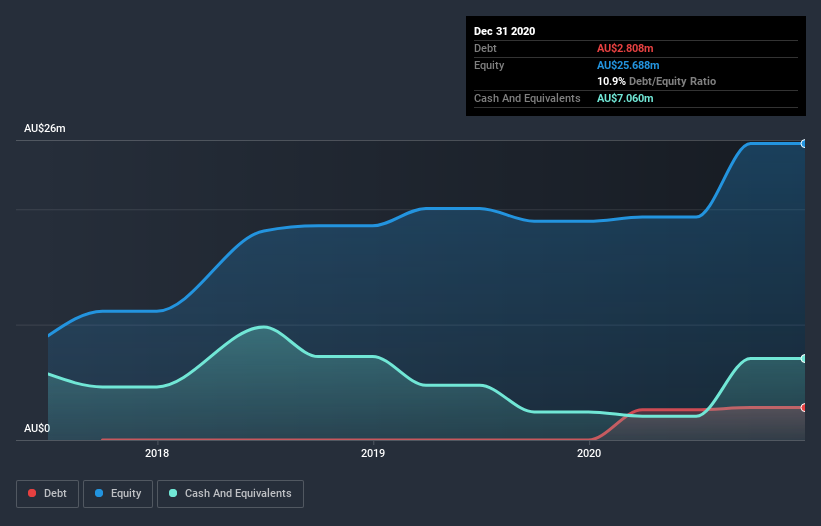Is Cobalt Blue Holdings (ASX:COB) Using Debt In A Risky Way?
David Iben put it well when he said, 'Volatility is not a risk we care about. What we care about is avoiding the permanent loss of capital.' When we think about how risky a company is, we always like to look at its use of debt, since debt overload can lead to ruin. We note that Cobalt Blue Holdings Limited (ASX:COB) does have debt on its balance sheet. But the real question is whether this debt is making the company risky.
When Is Debt Dangerous?
Debt is a tool to help businesses grow, but if a business is incapable of paying off its lenders, then it exists at their mercy. Part and parcel of capitalism is the process of 'creative destruction' where failed businesses are mercilessly liquidated by their bankers. However, a more usual (but still expensive) situation is where a company must dilute shareholders at a cheap share price simply to get debt under control. Of course, the upside of debt is that it often represents cheap capital, especially when it replaces dilution in a company with the ability to reinvest at high rates of return. The first step when considering a company's debt levels is to consider its cash and debt together.
See our latest analysis for Cobalt Blue Holdings
What Is Cobalt Blue Holdings's Debt?
You can click the graphic below for the historical numbers, but it shows that as of December 2020 Cobalt Blue Holdings had AU$2.81m of debt, an increase on none, over one year. However, its balance sheet shows it holds AU$7.06m in cash, so it actually has AU$4.25m net cash.
How Strong Is Cobalt Blue Holdings' Balance Sheet?
The latest balance sheet data shows that Cobalt Blue Holdings had liabilities of AU$1.94m due within a year, and liabilities of AU$2.33m falling due after that. On the other hand, it had cash of AU$7.06m and AU$69.0k worth of receivables due within a year. So it can boast AU$2.86m more liquid assets than total liabilities.
This surplus suggests that Cobalt Blue Holdings has a conservative balance sheet, and could probably eliminate its debt without much difficulty. Simply put, the fact that Cobalt Blue Holdings has more cash than debt is arguably a good indication that it can manage its debt safely. There's no doubt that we learn most about debt from the balance sheet. But it is Cobalt Blue Holdings's earnings that will influence how the balance sheet holds up in the future. So if you're keen to discover more about its earnings, it might be worth checking out this graph of its long term earnings trend.
Since Cobalt Blue Holdings has no significant operating revenue, shareholders probably hope it will develop a valuable new mine before too long.
So How Risky Is Cobalt Blue Holdings?
Statistically speaking companies that lose money are riskier than those that make money. And in the last year Cobalt Blue Holdings had an earnings before interest and tax (EBIT) loss, truth be told. Indeed, in that time it burnt through AU$4.5m of cash and made a loss of AU$2.4m. Given it only has net cash of AU$4.25m, the company may need to raise more capital if it doesn't reach break-even soon. The good news for shareholders is that Cobalt Blue Holdings has dazzling revenue growth, so there's a very good chance it can boost its free cash flow in the years to come. While unprofitable companies can be risky, they can also grow hard and fast in those pre-profit years. The balance sheet is clearly the area to focus on when you are analysing debt. However, not all investment risk resides within the balance sheet - far from it. Be aware that Cobalt Blue Holdings is showing 6 warning signs in our investment analysis , and 4 of those don't sit too well with us...
If you're interested in investing in businesses that can grow profits without the burden of debt, then check out this free list of growing businesses that have net cash on the balance sheet.
This article by Simply Wall St is general in nature. It does not constitute a recommendation to buy or sell any stock, and does not take account of your objectives, or your financial situation. We aim to bring you long-term focused analysis driven by fundamental data. Note that our analysis may not factor in the latest price-sensitive company announcements or qualitative material. Simply Wall St has no position in any stocks mentioned.
Have feedback on this article? Concerned about the content? Get in touch with us directly. Alternatively, email editorial-team (at) simplywallst.com.

 Yahoo Finance
Yahoo Finance 
